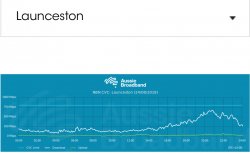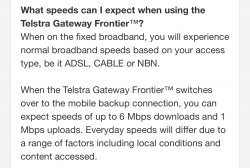I'll get back to you on that ... like I said there is nothing been said, or written in the Critical Info Summary about throttling the 4G backup. I can call on the recording where I placed my order and they read their T&C script if they do try it (I took lots of notes each call

).
My biz 500 Gig /mo 40 Mbps plan with Telstra will be $80/mo, but with biz tax deduction, will be a fair bit less than that out of my pocket. As i'm in a town where most places are unoccupied except at holiday time (ie shacks), I have a (slim) hope that I'll consistently get better than 40 Mbps
What are 'POI' and 'CVC' and what are their significance, please?
4g backup speed 6 Mbps - Telstra gateway modem:
The 4g backup is not an nbn service. So has nothing to do with NBN. Telstra is just being sneaky in not telling their customers what the backup speed really is. Download is 6mbps and upload is 1Mbps. Its a backup to keep you ticking over and not meant to replace the NBN service you paid for
Telstra's Gateway Frontier Modem Gives You A 4G Backup For Your ADSL Or NBN
 POI:
What is a POI? How and where your provider connects to the nbn™ network | nbn - Australia's broadband access network
POI:
What is a POI? How and where your provider connects to the nbn™ network | nbn - Australia's broadband access network
The NBN network is the " last mile" from the POI (Point of interconnect) to the customer. There are 121 throughout the country
41NSW, 30VIC, 22QLD, 14WA, 9SA, 2TAS, 2ACT, 1NT
The internet providers operate and own/lease the part of the internet between the POI and the World Wide Web.
NBN operates the part of the internet between the POI and the Customer
In reality the POI is like a big NBN exchange that sits in buildings hosting other major telstra exchanges (usually)
So you are FTTN. This means that its copper from your house to the (ex) Telstra pillar then FTTN Node. Then fibre from the Node goes upstream aggregating with other fibres then connecting into the NBN Transit Network which takes it all into a POI.
The Internet providers rent the NBN network to provide the last mile connection seamlessly on their netwok from WWW to your premises.
CVC:
Each RSP (retail service provider) rents from NBN a path to their customers. The path is called the CVC (connectivity virtual circuit) Its a circuit because the path goes both ways. The larger the path the greater the CVC - like lanes on a highway. Congestion occurs when the RSP doesw not rent enough lanes or paths. So traffic slows down like a traffic jam. When you buy NBN at 50Mbps its like buying a car which has a top speed of 50kmh. You cant go faster than 50kmh even if the speed limit is 100kmh (unless you buy NBN 100). The problem is when the actual top speed due to inadequate CVC provision is less than the top speed of your car (eg due to not enough lanes) - say 10kmh (or 10Mbps) even when you paid for a 50 car. When the RSP rents enough CVC, each customer's car will be able to travel at the speed it was purchased for. The "car" is called AVC (access virtual circuit).
Significance:
So your AVC is 50mbps, due to congestion your typical evening speed is 40Mbps. The RSP is supposed to buy enough CVC to make sure that the evening congestion is not severely affected.So NBN wholesales each AVC with a certain amount of CVC.
Some parts of the NBN cannot have speeds greater than 50Mbps - especially Fixed wireless and FTTN. So its then no use renting a AVC at greater than 50Mbps. Might as well go to a 25Mbps AVC.
The CVC is therefore the aggregate number of 'lanes' at the POI. In a way the POI is an artificial bottleneck put in place to extract revenue. This is where NBN gets its revenue. Want less bottleneck? - pay up!. The path between the house and POI can also be congested. This is currently seen with Fixed wireless. One fibre from a group of towers to the POI is carrying a lot more premises than an FTTN Node which is about 200 premises per fibre. FW is over 2000 per fibre. FTTN is not seeing congestion.
So when you buy NBN internet access what you are buying is the AVC rental (the car that takes you data to/from the POI at a certain top speed) and a bundled amount of CVC. If your AVC is 50Mbps you do not need to rent 50Mbps of CVC. NBN is a shared highway and
not everyone is using the internet at the same time and not everyone is online all the time. You might only have 2Mbps CVC as part of your plan bundled with the AVC, but aggregating every customer at Launceston POI combining everyones bundled 800Mbps CVC means that the customers are able to get their speed they pay
for when they are using the internet - around 40Mbps in the evening.
In the graphs above Aussie Broadband is renting at the Launceston around 800Mbps CVC (straight line) which is greater than the total demand (shown by the squiggly graph) so congestion is not going to be severely affected.
A big RSP like telstra does not publish their CVC graphs and may get more congestion than a small RSP like Aussie Broadband. Size is not necessarily an indicator.
Aussie broadband sells NBN50 (typical evening speed 45Mbps + 500GB/month at $74 on a month to month no lockin contract.
NBN does not wholesale gigabytes/month so why is the RSP selling gigabytes/month
NBN just rents out lanes (CVC) and cars of certain max speed (AVC). It does not care how many cars are on the road. The more cars the better because the RSP has to rent more CVC.
The RSP on the other hand does. The more cars on the road the more CVC it has to rent. The RSP then limits the number of times the car can travel on the road by introducing gigabytes/month. a 200Gb/month user will be on the road less than a 500Gb/month user. Therefore less CVC is necessary to support a 200Gb/m compared to a 500Gb/m user.


















